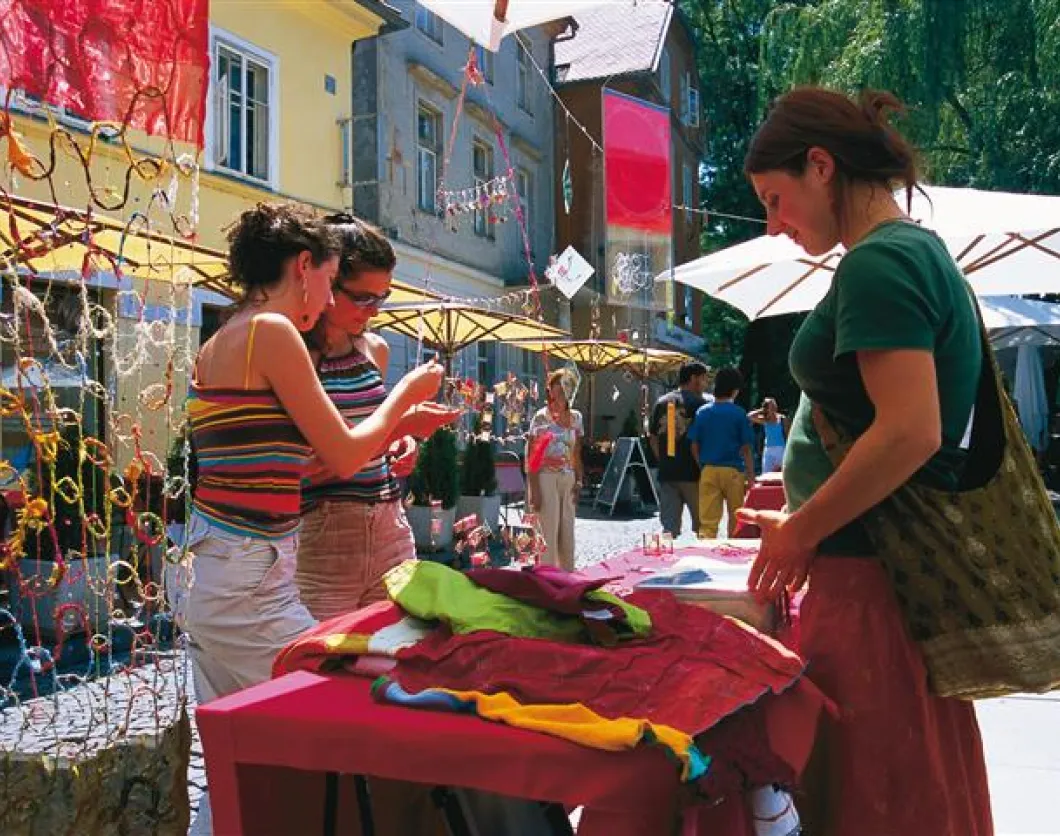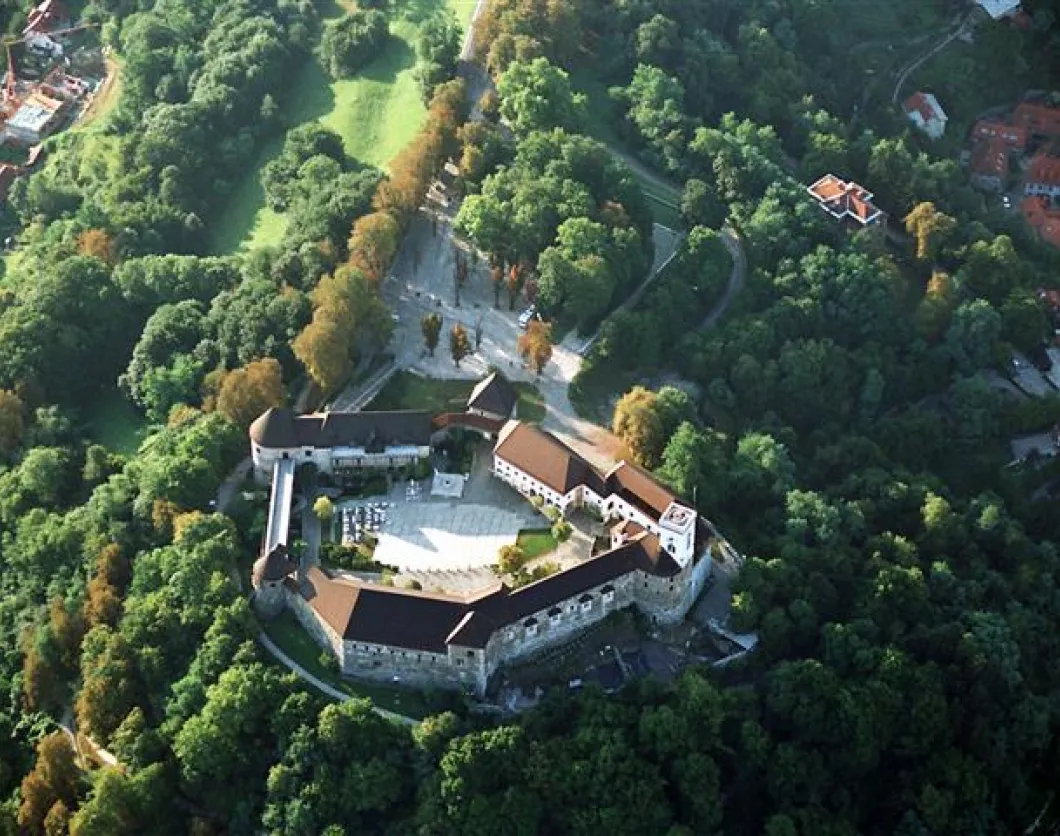Ljubljana, the capital of Slovenia, is a central European city lying between the Alps and the Adriatic Sea, in a basin where the Ljubljanica River flows into the Sava. It has all the facilities of a modern capital, and yet it has preserved its small-town friendliness and relaxed atmosphere. It is a vibrant city full of surprises. Its surrounding areas, packed with natural beauty and cultural sights bearing witness to the city's dynamic history, are renowned for their walking, hiking and cycle trails and a wide variety of culinary delights.
Young & Old
Ljubljana has preserved evidence of a five-thousand-year history including, among others, the remains of the Roman city of Emona and the old city centre with its medieval castle, Baroque façades, decorative portals and uneven roofs. Other significant bits of the city mosaic are picturesque bridges across the Ljubljanica River and the vast Tivoli Park, which stretches into the very city centre.
Ljubljana's present appearance is influenced partly by the Italian Baroque and partly the Art Nouveau, which found expression in numerous buildings constructed after the earthquake of 1895. In the second half of the 20th century, it was the world-famous architect Jože Plečnik that put an indelible personal stamp on his native Ljubljana. The city's appearance was further shaped by his students and a new wave of renowned young Slovenian architects.
Ljubljana's character is formed by a unique and felicitous mixture of two very different but complementary features: on the one hand, the city is famed for its historical heritage and tradition, but on the other, it is a relatively young city with a modern lifestyle whose residents' average age is only slightly above 30.
Places to see
In Ljubljana, the old meets the new; and it seems that history has spent all of the settlement's five millennia preparing it to become the nation's capital.
Ljubljanski grad (Ljubljana Castle)
The central point of interest of Ljubljana is the Castle Hill. Excavations testify that the hill was first fortified in the time of the Celts and Illyrians and that the Romans had a military post there. The beginnings of the medieval castle go back to the 9th century, although the castle building is first mentioned only in 1144. At that time it was the seat of the provincial ruler Spanheim, who even minted his own coinage here. It gained its present image after the earthquake of 1511 and with further renovations at the beginning of the 17th century. It was occupied by the provincial rulers until the first decades of the 17th century, later becoming simply a garrison and provincial prison. The castle’s renovation is now nearly completed, so that the two wedding suites, the tower, chapel and cafeteria are open to visitors, while the rest of the reconstructed premises are used for occasional performances, exhibitions and social functions.
Rotovž (Town Hall)
The first building erected here in 1484 was rebuilt in 1718 to the plans of the architect Gregor Maček. It has preserved a number of memorials of Ljubljana’s past, including the Hercules and Narcissus fountain (the work of Robba’s workshop) and the Gothic auditorium, in which Ljubljana residents attended theatrical performances by itinerant comedians in the 16th and 17th centuries. Today it is the seat of the Ljubljana City Council. In front of the building there stands one of the most representative monuments in Ljubljana, the fountain with allegorical sculptures of the three Carniolan Rivers the Sava, Krka and Ljubljanica. It was created in 1751 by Francesco Robba, the most important Ljubljana sculptor of the 18th century.
Prešernov trg (Prešeren Square)
This square is named after the greatest Slovene poet, France Prešeren (1800-1849). His poetry is a symbol of longing for love and freedom, which is why one of his poems, “A Toast” became the national anthem. The monument to Prešeren was unveiled in the autumn of 1905 and is the work of architect Maks Fabiani and sculptor Ivan Zajc. The square, based on the Italian model, is dominated by the ornamented facade of a Franciscan Church, built between 1646 and 1660. Its great altar is the work of sculptor Francesco Robba, from the mid-18th century. The vaults were painted by Matevž Langus in the mid-19th century, and repainted in the 1930’s by Matej Sternen. The Art Nouveau facades of “Ura” and “Centromerkur” are also a characteristic of Prešeren Square. Tromostovje (Triple Bridge), a special feature of Ljubljana’s architecture, is made up of an old stone bridge from 1842 and two side ones, which architect Jože Plečnik added in 1931 together, they provide an elegant entrance into the Old Town.
Zmajski most (Dragon Bridge)
The Dragon Bridge, designed in Art Nouveau style, stands by the market place and was built in 1901 on the site of the former wooden “Butcher’s Bridge”. It was named after the Emperor Franz Joseph, although only on paper, since the name was never adopted in practice. The bridge is a concrete and iron structure and was among the first of this type in Europe. Conceived by architect Otto Wagner’s pupil, Jurij Zaninovich, it features 4 statues of dragons and is considered one of the city’s landmarks.
Captivating capital
Slovenia’s Baroque style capital city, Ljubljana, is home to some of Europe’s art nouveau gems. Slovenia’s architectural son, Jože Plečnik, saw the city as the new Athens, modelling its castle on the Acropolis and the National Library on the Hellenistic Library. This lively capital is where the old meets the new. Locals say it’s a ‘city made to measure’ as it offers all the friendliness of a small town yet at the same time everything that a capital city should offer. Every year Ljubljana comes alive when it hosts many national and international festivals and exhibitions of art, music and culture. (Slovenia Tourist Board)
Photo: Visitljulbljana.si
In cooperation with Ljubljana Tourist Board










